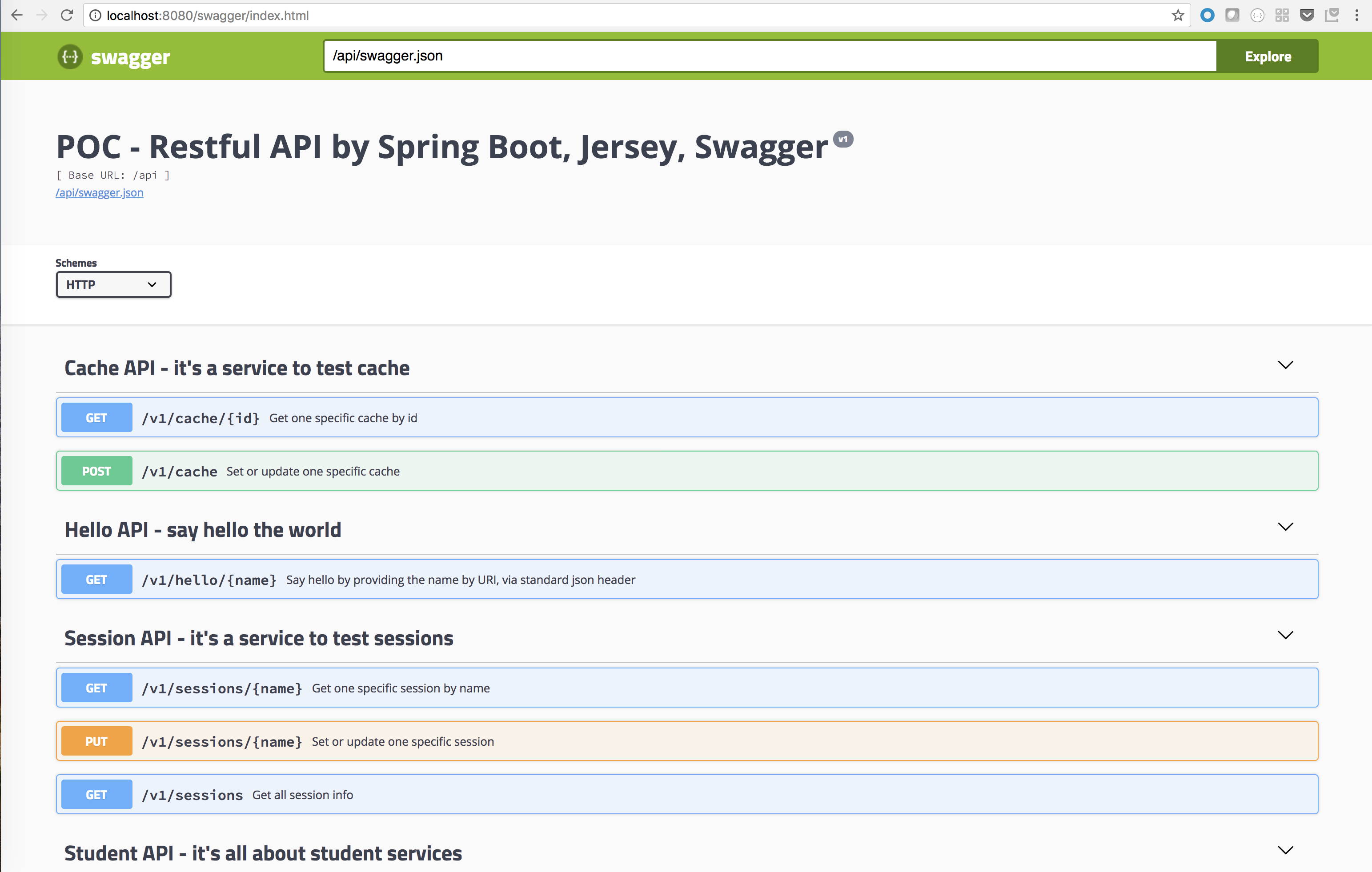This is a proof-of-concept project to build RESTful web services by integrating below components:
- Spring Boot - The foundation of our web app which uses below sub projects
- org.springframework.boot:spring-boot-starter
- org.springframework.boot:spring-boot-starter-web
- org.springframework.boot:spring-boot-starter-actuator
- org.springframework.boot:spring-boot-starter-jersey
- org.springframework.boot:spring-boot-starter-jdbc
- org.springframework.boot:spring-boot-starter-log4j2
- Spring Session - The abstraction layer for session + distributed cache (e.g. Redis)
- Spring Cloud Connector - connecting to services and gaining operating environment awareness in cloud environments
- org.springframework.cloud:spring-cloud-spring-service-connector
- org.springframework.cloud:spring-cloud-cloudfoundry-connector
- Jersey - The JAX-RS reference implementation for building RESTful web services
- Swagger - The de-facto API documentation framework
- Flyway - Database migrate/upgrade automation
For testing, we use below components:
- Spring Boot Test Framework (spring-boot-starter-test) with Junit, Hamcrest
- Rest Assured
- How To Integrate Spring Boot, Jersey, Swagger, Spring Session, Spring Cloud Connector, and Flyway to build real world JSON-based RESTful web services
- Unit Test practices for RESTful API testing
There is a dependency on Redis, as the cache by default, and I don't want to make it an embedded service, so before you start it up, do this:
$ curl -OL http://download.redis.io/releases/redis-4.0.8.tar.gz
$ tar xzf redis-4.0.8.tar.gz
$ cd redis-4.0.8
$ make
$ src/redis-server
Note: to clean up previsouly cached data, try
src/redis-cli -h localhost -p 6379 flushall
Check out the code and execute below commands:
$ mvn package
$ java -Dspring.profiles.active=dev -jar target/springboot-jersey-swagger-1.0.0-SNAPSHOT.jar
Note: activate
devprofile while running locally.
$ curl -X GET http://localhost:8080/api/v1/hello/Bright
{"msg":"Hello Bright - application/json"}
$ curl -X POST "http://localhost:8080/api/v1/cache" -H "Content-Type: application/json" -d "{ \"id\": 123, \"name\": \"Bright\", \"passportNumber\": \"G123456\"}"
$ curl -X GET "http://localhost:8080/api/v1/cache/123"
{"id":123,"name":"Bright","passportNumber":"G123456"}
To view Redis cache:
$ src/redis-cli -h localhost -p 6379
$ localhost:6379> keys *
1) "bright.zheng.poc.api.model.Student:123"
2) "bright.zheng.poc.api.model.Student"
3) "bright.zheng.poc.api.model.Student:123:phantom"
...
This one is easy to play with Swagger UI as session id is reused automatically in browser. For cli, we need to prepare the cookie file (refer to cookies.txt in Chrome) before playing with the APIs.
$ curl --cookie ~/temp/cookies.txt -X PUT "http://localhost:8080/api/v1/sessions/user1?value=ABC" -H "accept: application/json"
$ curl --cookie ~/temp/cookies.txt -X GET "http://localhost:8080/api/v1/sessions/user1"
{"user1":"ABC"}
$ curl --cookie ~/temp/cookies.txt -X GET "http://localhost:8080/api/v1/sessions"
{"user1":"ABC"}
$ curl -X GET "http://springboot-jersey-swagger.cfapps.io/api/v1/students/" -H "accept: application/json"
[{"id":10001,"name":"Ranga","passportNumber":"E1234567"},{"id":10002,"name":"Ravi","passportNumber":"A1234568"},{"id":10003,"name":"Bright","passportNumber":"C1234568"}]
$ curl -X GET "http://springboot-jersey-swagger.cfapps.io/api/v1/students/10003"
{"id":10003,"name":"Bright","passportNumber":"C1234568"}
Open a browser and key in URL:
$ open http://localhost:8080/swagger/index.html
Note:
- All the APIs can be playing through the UI
- Do switch the Schemes to "https" if you're using https protocol like in Pivotal Web Services
Yes, it's totally ready to be deployed to cloud. For example, deploying to Pivotal Web Services is just some commands away:
$ cf create-service rediscloud 30mb redis-for-springboot-jersey-swagger
$ cf create-service cleardb spark mysql-for-springboot-jersey-swagger
$ cf services
...
name service plan bound apps last operation
mysql-for-springboot-jersey-swagger cleardb spark springboot-jersey-swagger create succeeded
redis-for-springboot-jersey-swagger rediscloud 30mb springboot-jersey-swagger create succeeded
$ cf push -f manifest-qa-with-services.yml
$ cf apps
...
name requested state instances memory disk urls
springboot-jersey-swagger started 1/1 1G 1G springboot-jersey-swagger.cfapps.io
# open https://springboot-jersey-swagger.cfapps.io/swagger/index.html
Note:
- For Redis, the
30mbplan ofrediscloudis free- For MySQL, the
sparkplan ofcleardbis free
